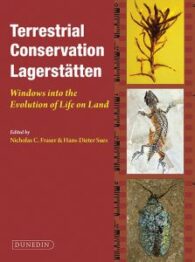By Nicholas C Fraser and Hans-Dieter Sues

Ever since Charles Darwin pointed out the problem, evolutionary biologists have been worried by the incompleteness of the fossil record. Whilst our knowledge of the diversity of life in deep time has greatly improved in recent years, many lineages of living animals and plants are still badly represented in the fossil record, including groups with hard parts that one would normally expect to make them more likely to be fossilised.
As a result, although the fossil record should be critical to our understanding of the evolutionary history of life, many biologists have questioned whether it really is that useful. Fortunately, discoveries of formations containing exceptionally preserved fossils (conservation Lagerstätten) have provided fascinating and important information on the history life’s diversity.
Palaeontologists distinguished between two types of Lagerstätten: concentration and conservation. The former are deposits with a larger concentration (usually very high) of disarticulated organic hard parts, such as bone beds.
The latter, which are the concern of this book, are deposits known for their exceptional preservation of fossilised organisms or traces, often of rarely preserved soft parts. These are central to providing answers to essential questions about the history and evolution of life. Perhaps, one of the most famous of these conservation Lagerstätte is the Burgess Shales of Canada, but that is a marine deposit. This book deals only with terrestrial deposits, notwithstanding that they mostly involve deposition in water (lakes, rivers and so on).
Terrestrial Conservation Lagerstatten has separate chapters, each written by international specialists (including such British fossil superstars as Dave Martill and Jennifer Clack), on nine famous terrestrial conservation Lagerstätten.
These are:
- The Rhynie and Windyfield cherts (an Early Devonian biota of terrestrial and freshwater plants and animals from Scotland).
- East Kirton limestone quarry (providing evidence of an Early Carboniferous ecosystem, also from Scotland).
- The Madygen Formation (Triassic life in an inland lake basin from Kyrgyzstan); the Solite Quarry (a late Triassic lake margin from the USA).
- The Yanliao biota (outstandingly preserved Middle to Late Triassic terrestrial life from China).
- The Jehol biota (an exceptional window into Early Cretaceous terrestrial ecosystems from China).
- The Santana Formation (excellent preservation and concentrations of vertebrate fossils from the mid-Cretaceous of Brazil).
- Messel Pit (a large number of exceptionally preserved animals and plants living in a large Eocene lake and its surrounds from Germany.
- Amber deposits, in particular, from Burma (the most productive source of inclusions in Cretaceous amber).
Those of you who were lucky enough to go to the Dinosaurs of China exhibition in Nottingham in 2017, which we covered in Issue 51 of this magazine, will be aware of just how amazing some of the finds are from the Jehol Biota (chapter 6), especially the actual holotype of Microraptor gui, one of many of the so-called ‘feathered dinosaurs’ from that country. And this book is illustrated by many beautiful, full-colour photographs of such fossils, not just from Jehol. I particularly liked the ones of the amber inclusions, but they are all extremely impressive and speak volumes both as to their importance and beauty.
However, this is not necessarily an easy (or indeed cheap) book to read, as it is written for those who possess a greater degree of academic knowledge than the average amateur geologist and palaeontologist. Therefore, it is really aimed at academic and student palaeontologists, and those amateurs who are willing to put some effort into understanding the issues involved and the academic language used.
That is not to say that this is just a specialist book. I am not a specialist and I thoroughly enjoyed both reading it and looking at the illustrations. And given that many of the Lagerstätten discussed are very well known (for example, the Rynie Chert of Scotland and the Messel Pit of Germany), I would recommend it to anyone willing to buy and read a book on such an important and fascinating aspect of palaeontology.
Terrestrial Conservation Lagerstätten, edited by Nicholas C Fraser and Hans-Dieter Sues, Dunedin Academic Press Ltd, Edinburgh (2017), 356 pages (hardback), ISBN: 9781780460147


